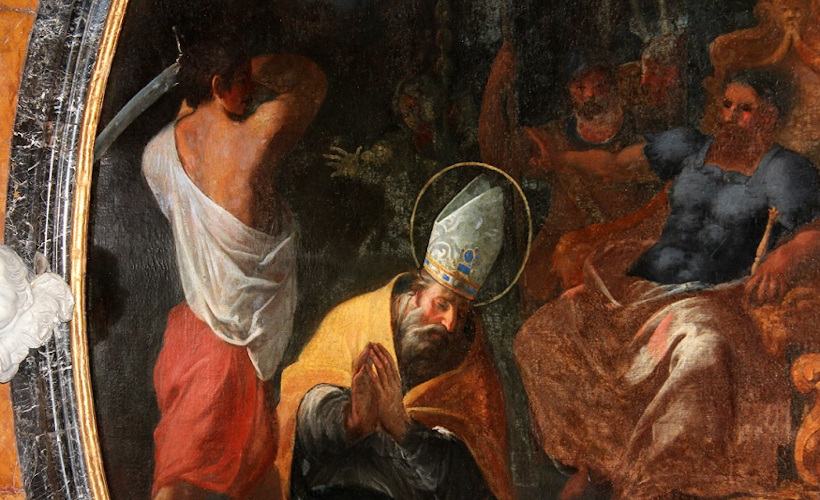Valentine lived between 175 AD. and 245 A.D. Finding reliable information about his biography is a difficult task, since the historical sources we have received are not perfectly reliable. For this reason, historians are cautious in evaluating the material that has come down to us. The most credible sources are the Martyrologists, the Passions, Liturgical Books, tombs, churches and iconography.
The earliest information on St. Valentine is found in the Geronymian Martyrology which was probably compiled in Italy between 460 and 544 AD. In this precious document, February 14 appears as the date of the death of Saint Valentine di Terni.
The historical value of the Geronymian is of the first order, both because it is considered a summary collection of information regarding the Saints of the first centuries, and because it has almost never been denied by archaeological discoveries.
In the book The cult of San Valentino Pompeo De Angelis reports the translation of a further Roman Martyrology, compiled by Cardinal Cesare Baronio and published in 1592.
On the date corresponding to 14 February we find two latercoli written in Latin and can be translated as follows: "In Terni, Saint Valentine, after having been beaten for a long time, was imprisoned and unable to overcome his resistance, finally at mid-night, secretly dragged out of prison , was taken off by order of the prefect of Rome Placido ».
The second reads: "In Rome, on the Via Flaminia, the birthplace of Saint Valentine, the Presbyter and the Martyr, who after a holy life in which he demonstrated a distinguished doctrine, was beaten to death and took off under Claudius."
Other information comes to us from the Passions which, compared to the Martyrologists, have undergone manipulations over time. However, precious reconstructive elements of the Martyr's story can also be collected from such documents.
The death suffered by St. Valentine must have strongly impressed the Church and the faithful, to the point that his devotion immediately spread throughout the Christian world.
In the figure we find the image of St. Valentine exhibited in the Basilica in Terni dating back to the sixteenth century. From Angeloni's account it seems that he belonged to a noble family, since he was young he devoted himself to studying and deepening the new religious ideas that immediately influenced him and his ardor led him to devote himself to spreading the Christian faith.
In the Passion of San Feliciano, Bishop Flaminii, we read that San Valentino was ordained Bishop of Terni in 197 by San Feliciano himself. Valentino immediately showed his attention and devotion to the needy. But he wasn't known for just that. His popularity was also due to the fact that he was able to heal incurable patients by performing countless miracles.
During the Council held in Rome in 250 by Pope Fabiano, Valentino restored health to a son of Fonteglio, who appeared mute and crippled and with his head between his knees.
He was committed to serving the poor, comforting widows, caring for orphans, the afflictions of prisoners, bringing consolation to sinners. He hoped to convert souls to God and bring happiness to others.
In 1888, on the First Mile of the Via Flaminia, in a cemetery known as Saint Valentine, where according to tradition the Saint was temporarily buried, some finds came to light. Among the many inscriptions that were recovered in the excavation, Orazio Marucchi studied some fragments belonging to a metric inscription composed by Pope Damasus in honor of St. Valentine.
In one of these fragments we read: "Damasus would have addressed a prayer to the martyr so that he would extend his protection, saving both those who were present in his sanctuary and those who recommended themselves to him from afar".
It also seems that Valentino "was accused of magic for the healings he performed, and could therefore be suspected that he was a doctor" and the same thing also seems to be noted in the Roman Martyrology, where we read of him that "post multa sanitatum et docrinae insigna" .
Numerous are the Passionaries who narrate the ability of Valentine's Day to cure the sick and his desire to spread the new ideas of Christianity among the faithful.
From the Passio Sancti Valentini, compiled in Rome between the fifth and sixth centuries, it is said that St. Valentine, who became famous for his great charity and humility, was martyred in Rome. A Passionary or Legendary of Lives de 'Santi, dating back to the 11th century and belonging to the Abbey of San Anastasio in Rome, without historical pretensions, reports the last miracle performed by the Saint, for which he was martyred.
Beyond the historical value of the news we have received, we must consider how much the faithful adored Valentine's Day and how they preferred to remember him as a character faithful to the ideals of Christianity, for which he committed himself throughout his life to the point of preferring death to the betrayal of one's faith.
The followers of Valentino, Proculus, Efebo and Apollonio, after his martyrdom, probably transported the Holy Body along the Via Flaminia. Arriving near the city of Interamna (current City of Terni) about 13 miles from the city of Rome, they gave the saint a worthy burial in the presence of some relatives and fellow citizens of Christian faith.
Some stories report that the death sentence by beheading was carried out in Rome during the night to avoid riots and reprisals of the Terni people, who loved and venerated their Bishop and illustrious citizen so much. In the place of his burial the faithful built an oratory and near the tomb of the Saint multiplied the requests of the faithful and other martyrs to be buried in that place.
From this complex documentation, the figure of St. Valentine emerges as an example of life and as a promoter of the values of Christianity during the period of decline of the Roman Empire.
A mixture of historical and legendary data can be seen from the stories of the Passionaries; for this reason it is difficult to obtain an exhaustive picture of all the news regarding Valentine's Day. Today, however, "it is believed that the legend itself is a fact, in the sense that it documents a mentality" and a sentiment of those who wanted to remember the Saint in his most authentic values.
Angeloni praises this character in this way: «Glory yourself, City of Terni, to have such a saint in Heaven, your citizen and the Protector; and with faith you have recourse to the pious intercession of the one in your needs; that he, in order to correspond to his piety, abundantly console you ».








Comments powered by CComment